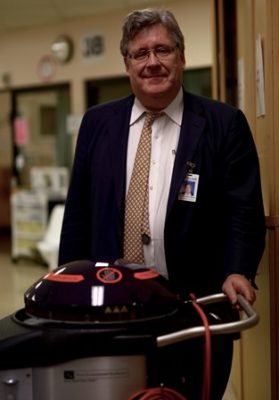By Elaine O’Connor
Burnaby Hospital has a new weapon against infection: the Germinator.
That’s the light-hearted name employees have given to the new Xenex Light Strike Robot cleaning machine. Yet it means serious business for patient care.
Fraser Health Infection Prevention and Control launched the Ultraviolet Germicidal Irradiation (UVGI) machine trials last month in three facilities: Burnaby, Ridge Meadows, and Abbotsford Regional Hospitals.
UVGI machines are cutting edge technology designed to reduce bacteria and viruses in health care facilities in tandem with traditional housekeeping and chemical cleaning methods. The machines emit short pulses of UV light which have a germicidal effect on stubborn microbes that normally linger on surfaces. The light damages the DNA and RNA of antibiotic-resistant pathogens including C. diff (Clostridium difficile), MRSA (methicillin-resistant Staphylococcus aureus), and vancomycin-resistant enterococci (VRE).
Hospital-acquired infections are a global concern. US Centres for Disease Control and Prevention statistics show one in every 25 patients contracts an infection while in hospital such as MRSA or C. diff and one in nine of these patients will die from their infection. In Canada, more than 200,000 patients contract infections in hospital each year and an estimated 8,000 will die.
The three robots, (dubbed “Violet” at Ridge Meadows and “The Force” at Abbotsford Regional) began their cleaning rounds in mid-November in selected units where there have been issues with hospital-acquired infections. The machines will be trialed for six months through to mid-May.
“Environmental cleaning is an essential component of our multi-pronged approach to reducing hospital-acquired infections,” says Executive Medical Director of Infection Prevention and Control, Dr. Elizabeth Brodkin. “The Germinator adds an additional layer on top of the good work our staff and cleaners do every day to keep our patients safe.”
The hospitals expect to see reduced rates of hospital-acquired infections along with a reduction in the costs associated with treating them, plus fewer outbreaks, better patient outcomes, decreased patient lengths-of-stay and a reduction in congestion at the sites. Some studies have shown that UV disinfection achieves a 99.4 per cent reduction in MRSA and a 100 per cent reduction in VRE. An earlier trial at Surrey Memorial Hospital demonstrated an 80 per cent reduction in bacteria cultured from surfaces in patient rooms, following disinfection with UVGI.

In December, Fraser Health President and CEO Michael Marchbank, Vice President of Patient Experience Linda Dempster and Dr. Brodkin visited Burnaby Hospital to catch the Germinator in action. Burnaby Executive Director Sheila Finamore, Director of Clinical Operations Coralei Still and Infection Prevention and Control consultant Fuad Ibrahimov gave a demonstration of the robot at work in a Medicine ward, where the machine disinfected a patient room with germicidal UV light.
Still, the Clinical Operations Director, said the pilot has been well received by patients.
“We’re really seeing the comfort that a deep clean of the environment brings to patients and their families,” she says. “The Germinator is a unique and very tangible way of showing our Burnaby community how much we care about their health and wellbeing and we’re thankful to our Aramark team, which has been so willing to support this quality initiative and to go the extra mile.”
The UV light that is used is bright, and while UV doesn’t penetrate deeply into tissues, it could cause slight damage to skin in the form of sunburn-like redness or retina sensitivity. For this reason, the disinfection units are operated by specially trained personnel and only in unoccupied rooms.
The UV rays can’t penetrate doors, glass or plastic, and no UV radiation remains once the unit is turned off, so there is no issue with exposure to individuals outside of the room— it’s safe to watch through a window. To prevent accidental exposure, the machine is also equipped with motion sensors to shut it down if they detect movement, and warning signs are posted outside the door during cleaning. It gives off a faint, harmless scent of ozone after cleaning.
Care aide Harjit Thind agreed patients have been enthusiastic about the enhanced cleaning, despite the fact they must be moved from the room during the treatment, which can take about 20 minutes for a small patient room and more for larger areas.
“I explain to them that it is a deep clean and their room will be more germ-free because we are trying to control the infection more,” Thind said. “As soon as they enter the room again and know it is really clean, you can see it on their face, they really love it.”
Elaine O’Connor is a Senior Communications Consultant at Fraser Health.


